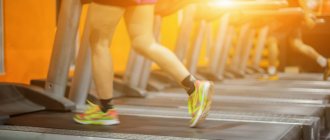What is cardio
The name “cardio” actually comes from the Greek word kardio - heart. Therefore, in theory, cardio training is training the cardiovascular system. However, in fitness rooms, “cardio” began to include any aerobic exercise in general: running, walking on an elliptical, cycling and most group “jumping exercises”.
Actually, cardio training, namely training the heart and cardiovascular system, is most effective within a certain heart rate range, so you need to constantly monitor it. You can determine your personal range accurately and individually by passing a test on a gas analyzer (here are our impressions of this procedure). Or just use the approximate formula: 220 - your age = your maximum heart rate. Cardio training should take place between 65% and 85% of your maximum heart rate. Accordingly, for a 30-year-old person this range is approximately 123-162 beats per minute. If you train below the lower limit, the training will not bring tangible benefits, if above it, it can do harm.
The same goes for “fat burning” on exercise machines, but don’t rush to believe them.
The topic of the pulse zone for fat burning is also very popular (possibly because it is often marked on cardio equipment in gyms): this zone is also determined individually using a gas analyzer test and it is slightly lower: about 60-70% of the maximum heart rate (115-135 beats/ min for the average 30-year-old person).
However, the most important thing about this is that cardio training for fat loss is not particularly effective (see below: why cardio training is not the best way to lose weight).
Fourth week
I started to play around: improvise and come up with sequences right in the process or remember the ones I had learned - fortunately, by that time I had already accumulated a lot of dance moves and steps from aerobics. I simply turned on music designed specifically for dance cardio training - it has a clear rhythm, usually the name even indicates the number of beats per minute.
I also added kilogram dumbbells, because again I felt that the load was not enough. In addition, this way it is distributed more evenly: the hands get more work, before only the legs were tired. conclusions
I really liked the experiment: I began to feel more energetic and positive, and became less irritated and worried. New beginnings were easier for me; after classes, interesting ideas often came to me, or I suddenly understood how to solve one of my current work or everyday problems.
I also unexpectedly debunked my own stereotype that dancing is not my thing. Everything just comes with practice, the main thing is to regularly devote time to it. In the process, I noticed an effect that was already familiar to me from the example of other activities. Quite quickly the body gets used to a certain load, “asks” for it and “rejoices” in it. As I already wrote, I still had to miss two days out of 28, and there was a clear feeling that something was missing. Although in the beginning, of course, before each workout I had to make some effort on myself.
In general, maintaining the regime was not difficult. I think it was largely due to the fact that I didn’t put pressure on myself, adjusted the classes to suit myself and understood the reasons for my reluctance to train if it arose. For example, a couple of times I preceded workouts with back exercises because I felt discomfort in my muscles. And if I understood that yesterday was too much, and today it’s difficult to force myself to give my all, I chose a lower intensity.
There has never been a time when I finished a workout in a bad mood or thinking “why did I waste my time on this?” When it comes to physical activity, something is better than nothing. It is not necessary to give 100% every time, the main thing is that this time was not spent on watching YouTube on the couch or eating too much pizza.
Who needs cardio training and for what purposes?
But first, let’s tell you who and in what cases cardio is recommended :
In fact, regular moderate cardio training is recommended for all older people specifically to keep the cardiovascular system in order and, in general, to prolong life.
Cardio helps during the period of fat burning, and interferes with it during weight gain. Choose.
- If you are trying to build muscle mass, then cardio training is not recommended, since its effect on muscle growth is somewhat opposite to hypertrophy. However, during the fat burning period (and you know that you cannot grow muscle and burn fat at the same time), having cardio in your training plan (but only together with strength training) will make your fat burning even more effective.
- If you're losing weight, adding cardio to your strength training is also a good idea. But remember that cardio is not the best way to lose weight.
- If you are involved in cyclic sports and you need to develop your endurance.
- Cardio for recovery. Light loads have a beneficial effect on the speed of recovery - we wrote extensive material about overtraining and its dangers.
"Cardio" is recommended by many as a warm-up for 5-7 minutes before training, just to warm up the body. However, calling it “cardio” would be wrong; it’s just a warm-up.
Second week
It became easier to remember the movements, and my brain no longer exploded in the last minutes of training. The load wasn’t enough, so on the tenth day I switched to a more intense series of videos.
The classes became firmly established in my schedule, and I finally found the optimal time for them - from 11 am. This happened, to my shame, after missing the ninth day. I then ran off to run errands, postponing training for the evening. As a result, things took longer than I expected, and in the evening a friend came to visit, and in the middle of the night there was no time for dancing.
In general, all the times when I planned a lesson for the evening, something always went wrong: either new work tasks appeared, or I had to stay late somewhere. So late morning is the best time for me. I just have time to work, sit too long and feel the need to switch to something active. Well, enough time passes after breakfast - it’s harmful to jump on a full stomach.
Cardio training is not the best way to lose weight
This is generally the most common misconception: women, afraid of “swinging” and hoping to lose weight, storm ellipses in all fitness rooms in the world. However, fears about “swinging” are completely unfounded and we have written more than once that this is completely impossible without steroids and hormones. But using exclusively cardio training to lose weight is probably the most common fitness misconception. If you are wondering why the world is so unfair, then read the text “Why do people lose weight not from running, but from weights.”
Yes, it’s true that, say, 45 minutes of cardio can “burn” more calories than during an equal-time strength training session, but the overall effect on weight loss will be worse. But strength training burns your fats mainly during rest, after your workout, significantly raising your overall metabolic rate. In addition, even a small amount of muscle that you may gain due to strength training (for example, 5 kg) requires an additional 250-400 kcal per day to your regular diet. This makes it easier for you to maintain a small calorie deficit and burn fat on an ongoing basis.
The best effect on fat burning is provided by a combination of full-fledged strength training and cardio training. In order to lose weight, fitness experts recommend 2-3 strength training sessions per week, flavored with 2-3 cardio workouts for 45-60 minutes. Moreover, it is advisable to conduct them on different days.
Energy sources
The only source of energy is adenazine triphosphoric acid or ATP. But its reserves in the body are negligible. They are enough for just a few seconds of hard work. Therefore, the synthesis and breakdown of ATP constantly occurs in the body. The body begins to use glycogen as a source of ATP formation.
Glycogen is the body's energy reserve. In reality it is a carbohydrate. Receiving glucose from food, the body stores its excess in the form of glycogen. Glycogen is stored in the liver and muscles. Glycogen stored in muscles is used as fuel for ATP during physical activity, that is, to ensure the vital activity of the muscles themselves. The reaction of glycogen breakdown (glycogenolysis) occurs anaerobically, i.e. without the participation of oxygen. And strength training is also called anaerobic precisely because the energy for muscle work comes from anaerobic glycogenolysis. But muscle glycogen reserves are also limited. And only when it runs out, the body can begin to use all three types of fats existing in the human body as an energy source. The most energy is converted from fat, but it is a reserve reserve, and the body will begin to consume it only when all other sources of energy have been exhausted.
How long to do cardio
Experts advise doing cardio for at least 30 minutes in order for the workout to have at least some effect. But do not forget that if you are completely new to the gym, then you need to start with easy 10-15 minute workouts and gradually increase the load.
Keep in mind that doing cardio for more than an hour will burn your muscles. Scientists have discovered that although aerobics “burns” fat, after an hour of exercise the body switches to muscle tissue. After two hours of cardio training, the body loses up to 90% of leucine, an amino acid that determines muscle growth.
Multiple Mr. Olympia Jay Cutler does not disdain cardio during the fat burning period
Here’s what one of the most famous jocks in the world, Jay Cutler, says: “during the preparation for the competition, I decided to push the aerobics and extended the aerobic training to an hour and a half. Immediately I noticed that there was less strength, the muscles “shrank” and lost their usual elasticity. Since then, I’ve been doing cardio for no longer than 45-50 minutes.”
Third week
It was possible to memorize the sequences faster and faster, and some dance steps and movements were repeated. So it became more and more pleasant moments when you just dance, without having to constantly look at the screen. I started to get creative and replace some movements with my own. This week I was sick, so I had to skip one lesson and work two at a lower intensity.
Cardio + strength
Let us repeat that muscle building and fat burning are not compatible, which means that it is not recommended to do cardio during the period of muscle building , but vice versa during the “cutting” period.
At the same time, it is recommended to do cardio on a separate day, but if you have to combine it, then it is better to do cardio training after strength training. If you start with cardio, you will use up glycogen and this will lead to a decrease in muscle strength, which means you will not be able to exercise your muscles enough.
But remember that fat burning is not a type of training, but a set of measures. First of all, you must eat less than you expend, and to ensure that your muscles do not leave your body along with the fat, you must maintain them with strength training.
But there were also some disadvantages:
Exercising every day is pleasant, but not easy - unexpected things may arise or you may feel unwell. For me, the ideal schedule is probably six days a week.
There is less time and energy left for other workouts: I almost abandoned aerial exercises and practically abandoned strength training for the lower body. So I think I'll stick to 30 minutes of cardio every other day and do 15 minutes of cardio combined with 30 minutes of strength training on other days. And, of course, after each class I will stretch for 15-20 minutes.
Of course, our experiment is not scientific at all, and reflects only subjective impressions. But it is based on serious research, so we highly recommend checking it out for yourself. Moreover, it is quite possible to carve out an hour for yourself, even if not every day, but at least 5-6 times a week.
Vlada Isakova, yoga instructor
Real best answer: free time cardio
It matters when the classes are convenient for you, taking into account the rhythms of the body and the workload of the day.
Why? Because honestly, just doing it first is always important. Because if you exercise at an inconvenient time for you, there is a chance that you will stop exercising due to irritation. You will start to hate cardio and eventually give it up completely.
Knowing that the benefits of morning cardio aren't as important to most people and adding that it may not be ideal for your schedule and preferences can help you make the best choice.
Day
If the goal is to strengthen the heart muscle, then exercising during the day will be a good choice. The body has enough nutrients; there have already been several meals. At the same time, there is still strength.
For the same reasons, the day is a bad choice if you are interested in fat burning. After all, first you will have to spend, so to speak, your available reserves. That is, mainly glycogen stored in the muscles. Only after this can we hope that fat deposits will be consumed. This is why it is often said that the effect of cardio exercise at a fat-burning rhythm appears only after 20-40 minutes.











